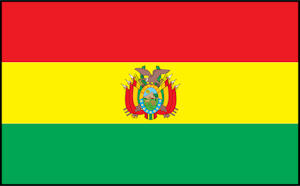Bolivia Flag Facts
-
Interesting Facts for Kids 1: Bolivia Flag
Bolivia began its fight for independence in 1809, with a new Bolivian Republic being declared on August 6, 1825. This South American country finally adopted the national flag in 1851. The National Flag of Bolivia can be described as a horizontal tricolor flag. The color of the stripes, from top to bottom, are red, yellow and green. -
Interesting Facts for Kids 2: Bolivia Flag
There are numerous reasons why these colors were chosen to feature on the flag. Some say that red stands for bloodshed, and in particular the Bolivian soldiers who fought for the country’s independence and freedom, and in subsequent conflicts. The color green symbolizes the nation’s fertility, and yellow represents the country’s mineral deposits. -
Interesting Facts for Kids 3: Bolivia Flag
Like many nations, Bolivia also has a formal State Flag, which features the coat of arms of Bolivia central to its design. -
Interesting Facts for Kids 4: The Coat of Arms of Bolivia
The coat of Arms of Bolivia has a complex design that is highly representative of the country’s history, struggle for independence, geography and resources. The coat of arms features a central crest and is encircled by a border which incorporates ten stars positioned around the bottom half. The stars represent the nine departments of Bolivia, and also Litoral, which was annexed by Chlie in 1879. Within the border, the coat of arms features the silver mountain, Pitosi, with the sun rising behind it. An Alpaca stands next to a tree and a wheat sheaf. An Alpaca can be described as a type of mammal related to the llama. It is a long-haired animal that originates from the continent of South America. -
Interesting Facts for Kids 5: The Coat of Arms of Bolivia
Six Bolivian flags, three on either side, surround the central logo. A pair of crossed cannons also feature on the coat of arms, symbolizing Bolivia’s struggle for independence. In addition to the cannon, four muskets also appear on the coat of arms. An axe and a red Phrygian hood are also depicted and represent liberty. The laurel branches are a symbol of peace, and the Andean condor highlights a willingness to defend the nation.
